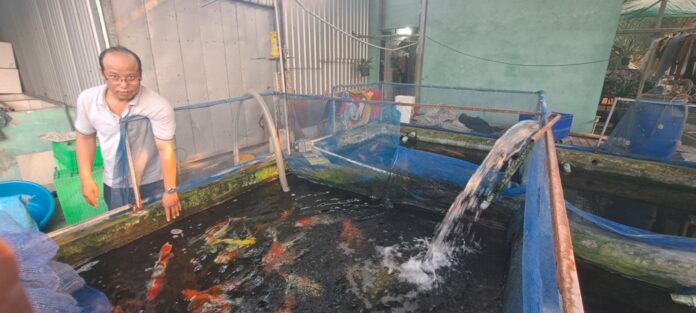Thanks to raising Japanese carp, koi fish, Mr. Truong Trung Cuong, who lives in Tan Nhut, Binh Chanh District, Ho Chi Minh City, has become wealthy. Cuong’s carp farming model is one of the key, typical, and highly economically effective models in the locality and Binh Chanh District.
According to Kinh Te & Do Thi newspaper, more than 20 years ago, Cuong moved from Tay Ninh to Ho Chi Minh City to attend university and started a family. He then settled in his wife’s hometown in Tan Nhut, Binh Chanh District.
“At that time, I was working for a foreign company, and during a few visits to an acquaintance’s house, I saw them keeping pet fish, so I bought some to keep as a hobby. But after successfully breeding them, I immediately thought of farming them for business and decided to quit my well-paid job at the foreign company,” Cuong recalled.

Cuong by the koi fish pond at his home (Photo: Tan Tien/Kinh Te & Do Thi)
In 2004, Cuong started his fish farming business. However, he faced challenges due to his lack of experience and capital. When the fish got sick, he didn’t know how to treat them as the internet was not widely available, and he had no one to guide him.
Cuong had to self-study from books to gain knowledge about treating fish diseases. When the fish grew bigger, he tried to sell them, but no one bought them. As a result, he had to send them to pet fish stores to sell on his behalf and only received payment after they were sold.
“In 2004, I sold my first batch of pet fish for 350,000 VND (equivalent to 5 taels of gold), so I decided to rent 3,000 m2 of land at Binh Phuoc intersection to invest on a larger scale. However, I continued to fail due to my inadequate techniques. Seeing the fish die in large numbers was very discouraging, but with my wife’s encouragement, I persisted. In 2006, I rented nearly 4 hectares of land in Tan Nhut to farm pet fish. In 2014, my wife and I gave up rice farming and focused entirely on pet fish farming. We also started exporting over 50 varieties of freshwater pet fish, both from our production and purchases from satellite fish farms,” Cuong shared.
Currently, Cuong’s household raises fish in hundreds of glass tanks and concrete ponds (covering an area of 1,300 m2). According to Cuong, for every cubic meter of water, about 200 carp fry are released. They have successfully bred the fry, significantly reducing costs for farmers.
Regarding food, all species share a common diet, mainly bloodworms, except for discus fish, which are also fed beef heart. Cuong’s pet fish consume between 5-10 kg of bloodworms daily, along with pellet feed and commercial fish food.
Cuong currently owns over 3 hectares of land for pet fish farming (a combination of owned and rented land). The various pet fish species, especially Japanese carp and koi, bring this farmer an average annual income of over 1 billion VND. Additionally, he provides employment opportunities for about 16 local workers, with salaries ranging from 5 million VND to 10 million VND per month.
In an interview with Dan Viet, Cuong shared that previously, the farmers in Tan Nhut Commune used to grow rice and raise meat fish, but the yields were low. Later, the fish ponds were improved and converted to carp farming. As this species is well-suited to the local natural conditions, the fish quality is excellent, and the demand in large cities like Ho Chi Minh is very high. Moreover, pet fish are also exported to many countries, resulting in economic value beyond expectations.
Currently, Cuong actively guides and shares his experience with farmers in the commune to develop pet fish farming in earthen ponds. He also commits to purchasing from more than 10 households in the commune, ensuring stable output and peace of mind for production.
“There isn’t a most favored pet fish species at the moment, so farmers must understand the market demands and preferences. Therefore, we cannot determine the most expensive fish. Each export batch depends on the order, sometimes 2,000 fish, sometimes 10,000 fish. Since pet fish are for entertainment and not consumption, there is no fixed rule. As pet fish are for recreational purposes, exporting them to other countries requires meeting stringent standards,” Cuong noted.



![[Photo Essay]: Experts, Managers, and Businesses Unite to Forge a Path Towards Sustainable Green Industry](https://xe.today/wp-content/uploads/2025/07/z678592918-218x150.jpg)


![[Photo Essay]: Experts, Managers, and Businesses Unite to Forge a Path Towards Sustainable Green Industry](https://xe.today/wp-content/uploads/2025/07/z678592918-150x150.jpg)


![[Photo Essay]: Experts, Managers, and Businesses Unite to Forge a Path Towards Sustainable Green Industry](https://xe.today/wp-content/uploads/2025/07/z678592918-100x70.jpg)






